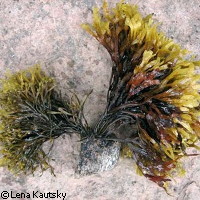Seaweed species in the Baltic forms quickly
New research from Sweden shows that a species of seaweed, discovered in 2005, may have formed only 400 years ago. Researchers from the University of Gothenburg and Stockholm University say the Fucus radicans species evolved from a Bladder wrack (Fucus vesiculosus) ancestor located in the Black Sea. Their findings, which show a natural example of evolution giving rise to new species in marine environments, were published in the journal BMC Evolutionary Biology. In a detailed study conducted 4 years ago, the researchers found that the Fucus radicans (F. radicans) was formed very quickly: from less than 2,500 years ago to as recently as 400 years ago. Their discovery adds weight to the theory of extremely-rapid species formation. Other examples of this type of formation include fruit flies, sockeye salmon and polyploidy hybrid plants. Another interesting result of this research is that new species can be formed in the 'relatively young and species-poor Baltic sea,' explained lead author Dr Ricardo Pereyra, a researcher from the Department of Marine Ecology at the University of Gothenburg. 'We are now working on understanding how the species was formed,' he added. The researchers used microsatellite markers to show the formation of the new species. Sympatric individuals of F. radicans and Fucus vesiculosus (F. vesiculosus) indicated significant reproductive isolation (i.e. a category of mechanisms preventing two or more populations from exchanging genes). According to the team, F. radicans is common in the Baltic; it is closely related to F. vesiculosus among north Atlantic populations. F. radicans also shows extensive clonal reproduction, which is probably triggered by the Baltic Sea's extreme conditions. It is this mode of reproduction, said the researchers, which is likely to have facilitated the rapid formation of the new taxon (group of organisms). 'The Baltic Sea, today a large, post-glacial brackish-water basin of the northeast Atlantic, hosts a low number of marine species. These species (together with a number of other now extinct ones), invaded the Baltic from the Atlantic during an earlier period of more marine conditions (4 000 - 8 000 years ago) and survived the shift 4 000 years ago to the present day, where the low-saline environment creates an unusual marine ecosystem,' the study reads. 'One of these species, the Bladder wrack (F. vesiculosus), is widely distributed in the sub-Arctic and temperate regions of [the] northern Atlantic, and is currently the dominant and ecologically important perennial, large brown alga in the Baltic.' The results of the study offer an example of rapid speciation in a species-poor open marine ecosystem, the researchers said. 'This observation also challenges presumptions that rapid speciation takes place only in hybrid plants or in relatively confined geographical places, such as post-glacial or crater lakes, oceanic islands or rivers,' the authors wrote. The results also fuel understanding of the role of species-poor systems, 'where competition is low and gene flow is expected to be high; of peripheral extreme environments and of mixed reproductive modes in species formation'.
Countries
Sweden



